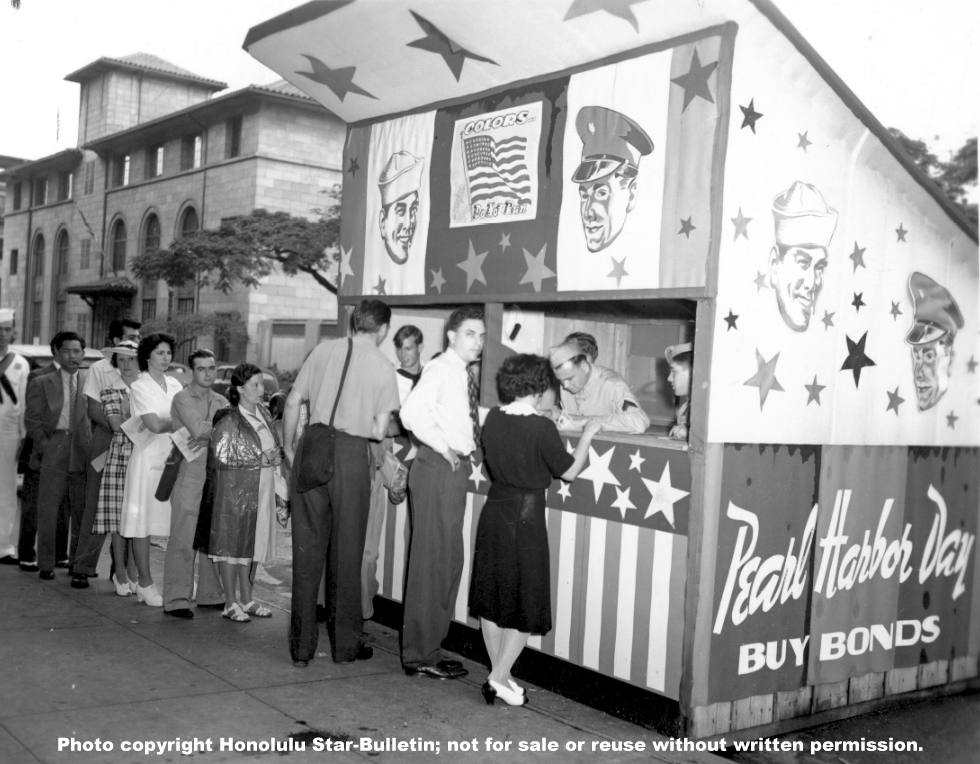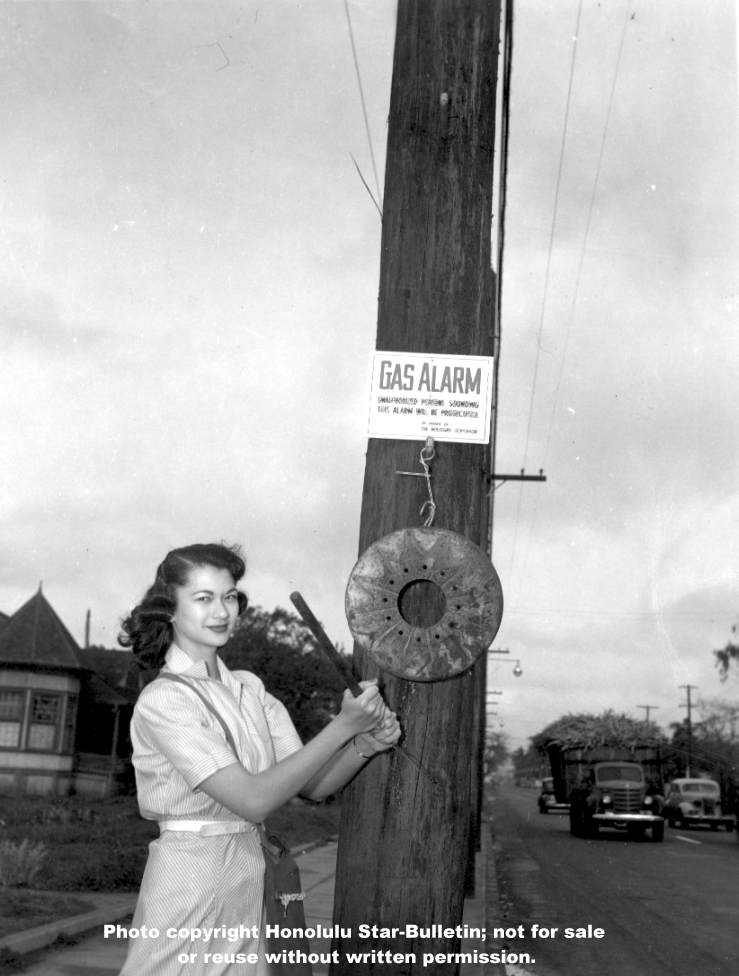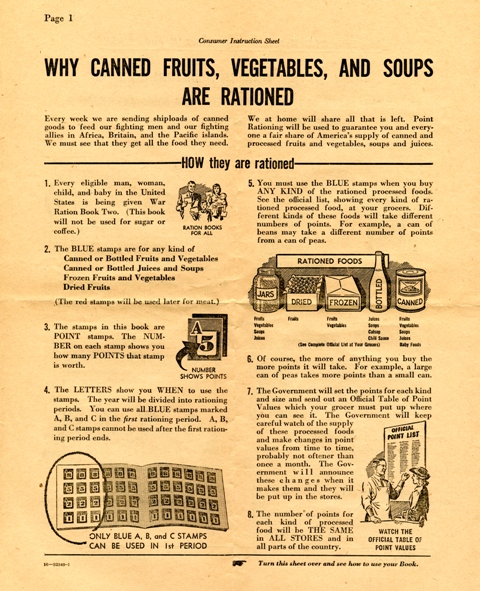As a result of the December 7, 1941 attack on Pearl Harbor, there were 2,403 people killed and 1,178 wounded. Among the deceased were 2,008 Navy personnel, 109 Marine, 218 Army and 68 civilians. (navy-mil)
World War II brought death to more than 300,000 Americans who were serving their country overseas. While the war was on, most of these honored dead were buried in temporary US military cemeteries.
(Punchbowl was not a cemetery at that time. In 1943, the governor of Hawaiʻi offered the Punchbowl for use as a national memorial cemetery; in February 1948 Congress approved funding and construction began. The first interment at Punchbowl was made January 4, 1949.)
(Initially, the graves at National Memorial Cemetery of the Pacific were marked with white wooden crosses and Stars of David; however, in 1951, these were replaced by permanent flat granite markers.)
After the attack on Pearl Harbor December 7, 1941, the Navy selected Oʻahu Cemetery to bury the dead. At the time, only 300 plots at the cemetery were available for use. Burials began there on December 8, 1941. (navy-mil)
“Historical records show that the Navy originally purchased plots in the cemetery October 9, 1919, and additional land was acquired in 1931. The current cemetery site was acquired April, 13, 1932.” (NAVFAC)
Several temporary cemeteries were constructed – one was in lower Hālawa Valley, overlooking Pearl Harbor.
“On Dec. 9 it became evident that sufficient land was not available in Oʻahu Cemetery for this purpose. By direction of the commandant (of the 14th Naval District), a site for a new cemetery was selected by the public works department. This site (Hālawa) was approved by the district medical officer and remaining burials were made in this new cemetery.” (US Naval Hospital; Cole)
Over the course of about 4-years, about 1,500 graves were prepared (some containing multiple sets of remains.) All bodies, except those of identified officers, were placed in plain wooden caskets. “Bodies of officers were placed in standard Navy caskets in order that they might later be disinterred and shipped home if desired.”
Two officers of the Chaplain Corps and two civilian priests from Honolulu rendered proper religious rites at the hospital and at the funeral ceremonies held each afternoon in the Oʻahu and Hālawa Cemeteries. The brief military ceremony held at the burial grounds included a salute fired by a Marine guard and the blowing of taps by a Marine bugler. (navy-mil)
Following the war, Congress passed, and the President signed, a bill that authorized the War Department to take steps to provide a reverent final burial for those who gave the last full measure of devotion.
“A first step in determining the final resting place for Americans who died outside the continental United States during World War II will be taken this week, Col George E Hartman, commanding officer of the Schenectady General depot, US Army, announced yesterday. … letters will be sent to more than 20,000 next-of-kin of American dead now in 15 of 207 temporary cemeteries overseas.”
“Next-of-kin may choose to have remains of WWII armed forces personnel who dies overseas returned to the US for burial in a private cemetery; returned to the US for burial in a National Cemetery; buried in a permanent US military cemetery overseas; or buried in a private cemetery in a foreign country which is a homeland of the deceased or next-of-kin.” (Schenectady Gazette, March 5, 1947)
In September 1947, the American Graves Registration Service (AGRS) disinterred and moved the remains to the Schofield Barracks Central Identification Laboratory (Schofield CIL), located at the AGRS Pacific Zone Headquarters, in order to effect or confirm identifications and return the men to their next of kin for burial.
Between August and September 1947, the US military exhumed 18 remains at Kāneʻohe Bay, 339 from Oʻahu Cemetery, and 1,516 at Hālawa, according to a 1957 government report. (Cole)
What was the Hālawa Naval Cemetery is the vicinity of the Animal Quarantine and Hālawa Industrial Park. (Currently, there are 135 Sailors, Marines and spouses interred in Oʻahu Cemetery.)








































































![Otto_Kuhn_(Kuehn)_Home-557_Kainalu Drive-(star-bulletin) 20040901-08 PRG SPY HOUSE There are two houses at 557 Kainalu in Kailua that are built very close to each other. This is the two story A fame house that is on the right side of the property. During the late 1930's it served as a den for a German spy who provided intelligence for the Japanese military leading up to the bombing of Pearl Harbor. The present owner, John Piper (225-3555) bought the houses in 1999. PHOTO BY DENNIS ODA. SEPT. 1, 2004. Nikon D2H Focal Length: 13mm White Balance: Direct sunlight Color Mode: Mode I (sRGB) 2004/09/01 12:35:19.1 Exposure Mode: Shutter Priority AF Mode: AF-C Hue Adjustment: 0¡ JPEG (8-bit) Fine Metering Mode: Multi-Pattern Tone Comp.: Auto Sharpening: Auto Image Size: Large (2464 x 1632) 1/250 sec - f/15 Flash Sync Mode: Not Attached Noise Reduction: OFF Exposure Comp.: 0 EV Lens: 12-24mm f/4 G Sensitivity: ISO 200 Image Comment: [#End of Shooting Data Section]](https://i0.wp.com/imagesofoldhawaii.com/wp-content/uploads/Otto_Kuhn_Kuehn_Home-557_Kainalu-Drive-star-bulletin.jpg?w=215&h=160&ssl=1)


